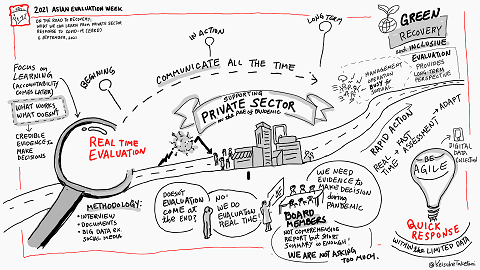My name is Keisuke Taketani. I do facilitation and visualisation. Watch a video at Asian Evaluation Week, explaining graphic facilitation .https://www.youtube.com/watch?v=uNaImYVBadk
My contributions
We produce many evaluations and a huge amount of evidence each year – but how much information are we really digesting?
Michael Quinn Patton, Founder and CEO of Utilization-Focused Evaluation, says that the most notable trend emerging among leading evaluators today is the increased importance of visuals. Visual tools, such as animation, infographics, and the use of graphic recording to present text and pictures during presentations, can help to transform complex information into more comprehensive “thinking tools”. However, many people might see visuals as less important or even childish.
In my role as WFP’s Regional Evaluation Officer for Asia and



Keisuke Taketani
Graphic facilitator FreelanceHi everyone,
I really enjoy the active discussion. It seems that we realize there are many aspects of visualization in terms of tools, audience, and purpose, and this is just the beginning of the beginning.
Coincidentally, I received a notice this morning that specialized online training in data visualization and evaluation is launched.
https://lovingvisuals.com/.
The person behind the course is someone I can trust in both evaluation and visualization. This could be a good venue for anyone who wants to use more visualization in evaluation reports and more.
Cheers,
Keisuke
Keisuke Taketani
Graphic Facilitation and Design
www.keisuketaketani.com
Keisuke Taketani
Graphic facilitator FreelanceDear Harriet,
Many thanks for starting a discussion close to my heart!
Let me share the latest development of WFP EvaluVision, as you kindly shared as an example. After trying to set a foundation of methodology, EvaluVision is now focusing on finding and strengthening local talent. WFP Nepal conducted a stakeholder workshop to discuss a baseline study of the school feeding program. I worked with a local artist to share the overall EvaluVision methodology. A documentary video is being edited at this moment, so I might be able to share it before this discussion closes.
Besides EvaluVision, I recently asked to help several WFP country offices to visualize the Theory of Change. After going through several technical workshops to formulate ToC, it was suggested to make a one-page visual without any technical terms. I proposed that, after drafting an illustration, organize a coloring contest where any staff or their family can participate. The winner was the daughter of the WFP staff. I realize this is more like a vision board than a Theory of Change, it helps to explain the overall purpose (how success looks like) and how we get there. More details and the winning entry on a LinkedIn post here
Another use, as wisely pointed out by Harvey Garcia in earlier posts is a crossroad of evaluation and data analysis. I see a big potential for using big data for evaluation. I am not a data scientist who can share many insights, but please allow me to share a graphic summary of a very interesting discussion of evaluation and artificial intelligence organized by EBRD last year. I suppose it's not so far future when AI will create a summary drawing if you upload a 100-page evaluation report. (or maybe is there such a tool available already?)
Cheers,
Keisuke
Keisuke Taketani
Graphic Facilitation and Design
www.keisuketaketani.com